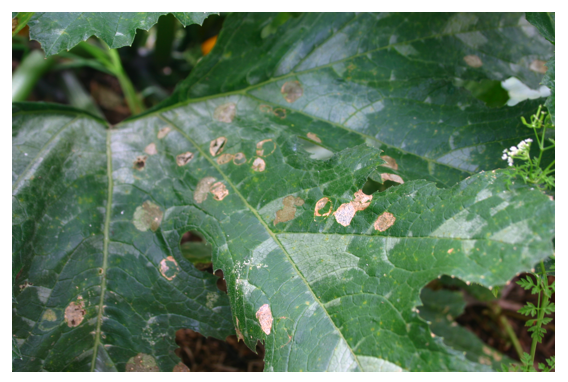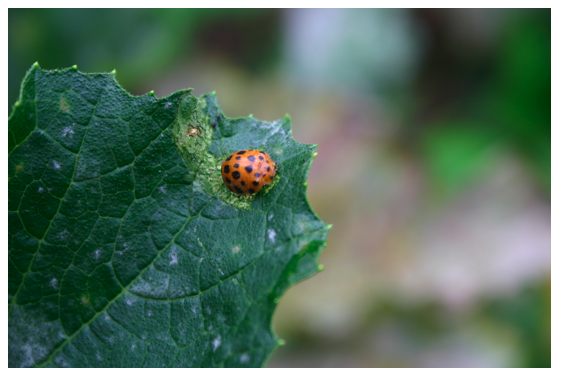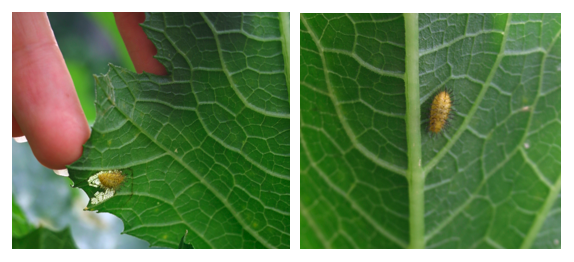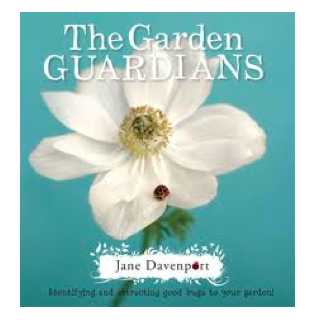Towards the end of summer we invariably start to see pests devouring plants and diseases ruining our crops. Some common problems arise every season and are predictable enough to take evasive action. One of these culprits is the 28-spotted ladybird.
What you’ll probably see is their destructive tell-tale signs before you actually see the beetles. One day your zucchini might look vigorous and healthy, the next it seems to have something akin to a bad case of the measles! Here’s a picture of my damaged zucchini leaves.

Whether you call them ladybirds, ladybugs or lady beetles, not all of them are created equal, apparently! With over 3000 species worldwide, including more than 400 here in Australia, there’s a lot of them about. The majority of them are beneficial in the garden, acting as natural predators against other pests, but this one isn’t a good guy. Here’s the adult ladybird munching away on my zucchini, making haste on a tasty dinner. Notice the number of spots, being much smaller than your regular ladybird.

Now have a look at what the juvenile form looks like. It’s yellow-orange body is covered with some hideous looking black spines. You would never guess that this creature turns into a ladybird, would you?

We often miss this stage because we look at our gardens from the top down. But underneath the leaf surface is where all the partying goes on. The eggs are laid on the underside of the leaf for protection from predators, then after it hatches, the larvae feeds voraciously on the leaf without us noticing. So it’s important to check under your leaves regularly for the first signs of these critters.
Now that you know what you’re looking for, you can discover them early. I simply remove them by hand and squash them or feed them to the chickens. Taking action early means that numbers don’t build up too fiercely and hand removal is all you will need without the use of any pesticide.
 A great book to find out what good bugs and bad bugs in your garden look like is Jane Davenport’s The Garden Guardians. Read my review here.
A great book to find out what good bugs and bad bugs in your garden look like is Jane Davenport’s The Garden Guardians. Read my review here.




 Twitter
Twitter Facebook
Facebook
Thank You for this. On mine the colour of the lady bugs are yellow and black. What do these do? I presumed they are the same as the ones pictured but maybe not.
Caterpillars are also attacking the silverbeet but I cannot catch them at it – just the results. Devasting.
Please help.
Thanks
Annette
Annette, the yellow and black ladybugs are fungus eating ladybugs and considered good (although some say they will actually spread powdery mildew further on the zucchini leaves as they move around). I leave them on the plant and don’t worry about them.
Read my previous blog post on controlling the caterpillars naturally … or you could try dipel (Bt).
Hi, I have these 28 spotted lady beetle on my zucchinis which after reading your article I will now remove by hand. I also however have an oval shaped beetle which is orange and has 4 large black spots and a small spot on it’s end. They look like they’re chewing on the leaves as well, what are these and how do I kill them (if they’re harmful)? Thank you.
Hi, I have an oval shaped orange beetle with 4 black spots and another on its end. Is this a pest and if so how do I get rid of it? It looks like it is chewing my zucchini leaves.
These are pumpkin beetles, not good. Just squash these when you first see them so they don’t get out of hand.
Thanks for all the tips! Hopefully I can go out tomorrow and pollinate my Zuccinni! Lots of help and the ladybugs I never knew about!♥️
Late spring in upper western new and the ladybugs are rampant, eating the flowers of my zucchini and pumpkin not allowing fruit to set. I’ve just noticed they are all over my Hawaiian guava too but underneath the leaves and not doing any damage but there’s so many of them
You could try a little bit of neem oil